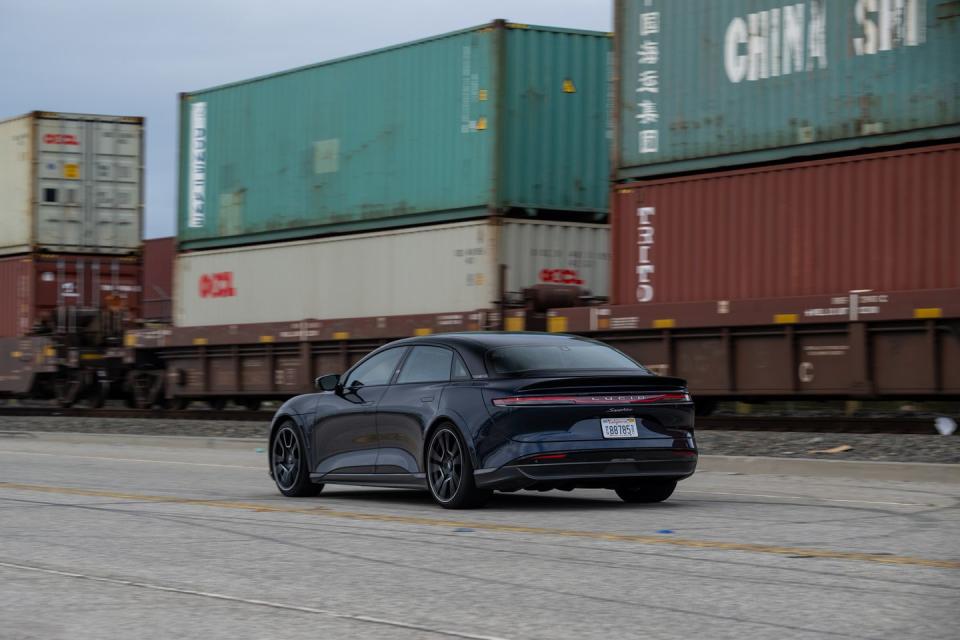2024 Lucid Air Sapphire Is the Quickest EV We've Ever Tested

The 2024 Lucid Air Sapphire is the quickest electric vehicle we've ever tested, beating out the Tesla Model S Plaid that last held the title.
The Sapphire's 2.1-second sprint to 60 mph tied the Plaid's time, but the Lucid was a tenth quicker to 100 mph and through the quarter-mile.
Lucid's 1234-hp all-wheel-drive sedan was even quicker to 130 mph, widening the gap by seven-tenths on its way to a 207-mph top speed—another EV record for us.
The Lucid Air Sapphire has cemented its place in the Car and Driver record book. Thanks to three electric motors that generate a seismic 1234 horsepower and instantly zap 1430 pound-feet of torque to all four wheels, the luxury electric sedan has become the quickest EV we've ever tested—not to mention joining our short list of all-time quickest cars.
Tesla Model S Plaid Dethroned
A 2021 Tesla Model S Plaid previously held the title of quickest EV ever tested by C/D. While the Sapphire tied the Plaid's incredible 60-mph time of 2.1 seconds, the Lucid hit 100 mph in 4.2 ticks and finished the quarter-mile in 9.3 seconds at 153 mph. Both of those results are a tenth better than the 1020-hp all-wheel-drive Tesla, which needed 4.3 seconds to hit 100 mph and 9.4 seconds at 151 mph to complete the quarter-mile.

For anyone who thinks that the Sapphire beating the Plaid by one tenth in those tests isn't a big deal, don't forget Dominic Toretto's famous words: "It doesn't matter if you win by an inch or a mile. Winning's winning." Better yet, let the Sapphire's other acceleration times prove its dominance. After accelerating past the 120-mph mark, the ballistic Lucid began to really separate itself from the Tesla, hitting 130 mph seven-tenths sooner at 6.0 seconds flat. As the speedometer hit 140, 150, and 160 mph, the Sapphire held leads of three-, four-, and five-tenths, respectively.
The comparison ends at that point because the Plaid we tested was limited to 162 mph, while the Sapphire topped out at an insane 207 mph. That puts the Lucid in, er, rarefied air, as we've only tested a handful of cars that have broken the 200-mph barrier. None of them were exclusively powered by electricity either. (The latest Plaid with the $20,000 Track Pack also claims 200 mph.)
Being the quickest is also helpful, but one of many impressive attributes that helped the Sapphire set EV and sedan lap-time records during our Lightning Lap test at VIR this year.
What's also extremely impressive about the Lucid breaking the Tesla's record is that the Sapphire had a curb weight that was 517 pounds heavier (5345 versus 4828 pounds). Technical Editor Dan Edmunds was the man who guided the electrified missile on its record-setting runs.
What About a Sub-2.0-Second 60-MPH Time?
Lucid has been promising a sub-2.0-second run to 60 mph, but that's at a fully prepped drag-strip surface. In fact, on such a venue at Sonoma Raceway our Edmunds indeed got the car to hit 60 mph in 1.9 seconds. Here's what he said had to be done. Sonoma Raceway is a pro-level NHRA drag strip, so its surface is coated with so much accumulated race rubber you might walk out of your shoes if they’re not laced tightly. It also has a water box to facilitate controlled burnouts for preheating the tires. With both on my side, my best run of 1.9 seconds to 60 mph topped out at 9.05 seconds and 154 mph at the finish line. It was like being shot out of a noiseless cannon.
Our test surface is made for testing consumer vehicles, not race cars. Ordinary asphalt, no water box, no burnouts. We also test in both directions and average the results—impossible on a drag strip. Apart from the lack of pre-heating and the two-way running, the approach is identical once you’ve selected drag strip mode: hold the brake firmly, mash the accelerator, side-step the brake, hang on. Traction control must be engaged for this, because it’s launch-optimized in drag strip mode. If you leave it off, the tires will light up (even at Sonoma—ask me how I know).
Considering the considerably less tacky tire/track interface, my two-way average of 2.1 seconds to 60 mph isn’t far off my drag strip time at all. That initial two-tenths difference holds true all the way down the quarter-mile, which ended after just 9.3 seconds at 153 mph. Thing is, it could have been better. The day started with a bit of light rain that dampened and cooled the surface. I had to wait for the sun to dry the tarmac before I could make my runs, but the track surface was probably cooler than it otherwise might have been. –Dan Edmunds
You Might Also Like

 Yahoo Autos
Yahoo Autos 